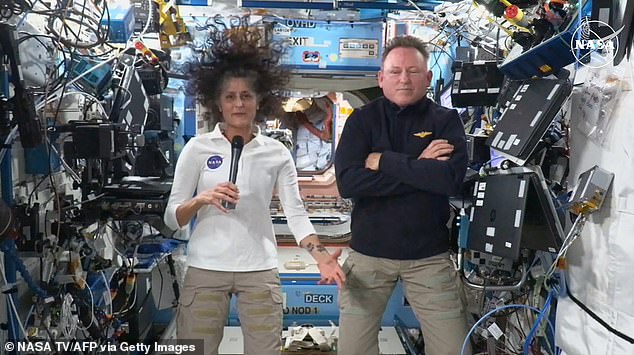The International Space Station (ISS) where two NASA astronauts were stranded for nine months is so clean it’s making crews sick, a new study suggests.
Astronauts typically live on the orbiting laboratory for up to six months, but NASA‘s Sunita Williams and Barry Wilmore were stuck there for more than nine months.
During such long-term missions, astronauts often experience immune system dysfunction, skin rashes and inflammatory conditions, but scientists have struggled to determine the exact causes of these spaceflight side effects.
Now, new research suggests these issues could be related to the ‘excessively sterile nature of the spacecraft.’
Earth is home to roughly one trillion species of microbes, some of which make people sick while others play critical roles in keeping the human body healthy.
But the ISS has a much lower diversity of microbes than our home planet, and most of the species that live there were carried there by astronauts, the researchers found.
The lack of good bacteria on the space station may be suppressing astronauts’ immune systems, making them more vulnerable to rashes, cold sores, fungal infections, shingles and other ailments.

The International Space Station (ISS) where NASA astronauts Sunita Williams (L) and Barry Wilmore (R) were stranded for nine months is so clean it’s making crews sick
The team collaborated with astronauts who swabbed 803 different surfaces on the ISS to create the most extensive survey of the space station’s microbiome yet.
Once the samples were brought back to Earth, scientists analyzed them to determine which bacteria species and chemicals were present.
To understand how the bacteria and chemicals might be interacting, they then created three-dimensional maps showing where each was found on the ISS.
Overall, human skin was the main source of microbes throughout the space station, and chemicals from cleaning products and disinfectants were found on nearly every surface.
But the microbial communities and chemicals varied in each space station module, and the differences seemed to be determined by the module’s use.
Unsurprisingly, dining and food preparation areas contained more food-associated microbes, where as the space toiled contained more urine- and fecal-associated microbes.
In general, the researchers found that the space station’s microbiome was far less diverse than that of most terrestrial environments.
The ISS samples were most similar to samples taken from industrialized, isolated Earth environments, such as hospitals, closed habitats and homes in urbanized areas.

Microbial and chemical samples taken from the ISS were most similar to ones taken from industrialized, isolated Earth environments, such as hospitals and homes in urbanized areas

The good bacteria in our bodies bolster the immune system, ward off infections, help the gut digest food, control inflammatory responses and more
The team found evidence to suggest that the high levels of disinfectant and cleaning chemicals on the space station are suppressing the diversity of its microbiome.
‘We noticed that the abundance of disinfectant on the surface of the International Space Station is highly correlated with the microbiome diversity at different locations on the space station,’ said co-first author and UC San Diego postdoctoral researcher Nina Zhao.
This may be driving certain health issues for astronauts living on the ISS.
‘Sterile environments are not in fact the safest environments,’ study co-author and UC San Diego professor Rob Knight told Space.com.
‘Exposure to beneficial microbes in the environment is important for maintaining health — this is not surprising because, as humans, we have coevolved with those environmental microbes for millions of years.’
The researchers concluded that increasing the microbial diversity aboard the space station could reduce some of the health risks of spaceflight.
‘Future built environments, including space stations, could benefit from intentionally fostering diverse microbial communities that better mimic the natural microbial exposures experienced on Earth, rather than relying on highly sanitized spaces,’ said co-first author and former UC San Diego biotechnology researcher Rodolfo Salido.
But this wouldn’t mean compromising on hygiene, the researchers say.
‘There’s a big difference between exposure to healthy soil from gardening versus stewing in our own filth, which is kind of what happens if we’re in a strictly enclosed environment with no ongoing input of those healthy sources of microbes from the outside,’ Knight said in a statement.
‘If we really want life to thrive outside Earth, we can’t just take a small branch of the tree of life and launch it into space and hope that it will work out,’ Salido said.
‘We need to start thinking about what other beneficial companions we should be sending with these astronauts to help them develop ecosystems that will be sustainable and beneficial for all.’
But before we can do that, further research is needed to assess whether microbes that are beneficial to humans on Earth could become harmful in space.
This risk could arise from the lack of microbial diversity on the ISS, which may allow certain species to propagate rapidly and exceed safe levels, or from increased genetic mutation of the bacteria due to space radiation.
‘These factors can be tested on Earth before proceeding to costly space experiments,’ Knight told Space.com.
This article was originally published by a www.dailymail.co.uk . Read the Original article here. .

